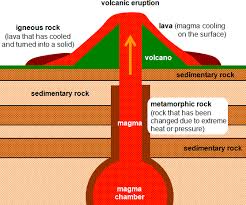Relevance: Prelims: Geography
The earth’s crust is made up of various types of rocks, differing from one another in texture, structure, colour, permeability, mode of occurrence and degree of resistance to denudation. A knowledge of these rocks is of paramount importance to geologists, who study the composition and physical history of the earth, but the geographer, too, needs a basic knowledge of the most common rocks and their relationship with landforms. Rocks also form the basis for soil, and determine to some extent the type of natural vegetation and land use, so we must have a fair acquaintance with the rocks around us. Generally speaking, all rocks may be classified into three major groups–igneous, sedimentary and metamorphic, according to their origin and appearance.
Igneous Rocks
Igneous rocks are formed by the cooling and solidification of molten rock (magma) from beneath the earth’s crust. They are normally crystalline in structure. They do not occur in strata (layers) nor do they contain fossils. Igneous rocks may be sub-divided on the basis of mineral compl>sition. When they contain a high proportion of silica theyare said to be acid. Acid igneous rocks, such as granite, are Jess dense and are lighter in colour than basic rocks. These contain a greater proportion of basic oxides, e.g. of iron, aluminium or magnesium, and are thus denser and darker in colour. In terms of origin there are two main classes of igneous rocks.
- Plutonic rocks. These are igneous rocks, formed at some depth in the earth’s crust. They have cooled and solidified slowly so that large, easily-recognized crystals have been able to form. These intrusive rocks, such as granite, diorite and gabbro, are exposed at the surface by the processes of denudation and erosion.
- Volcanic rocks. These are molten rocks poured out of volcanoes as lavas. They solidify rapidly on the earth’s surface and the crystals are small. Basalt is a common volcanic or extrusive rock and forms lava flows, lava sheets and lava plateaux, e.g. those of Antrim in Northern Ireland, the Deccan Plateau in India and the Columbia-Snake Plateau in U.S.A. Some kinds of basalt solidify in a very peculiar manner to form long polygonal columns. A well-known example is the columnar basalt of the Giant’s Causeway in Antrim. Some of the molten Java may push its way to the surface through clefts and passages, solidifying as vertical dykes or horizontal sills. Their origin and occurrence will be discussed in greater detail in Chapter 3. Most igneous rocks are extremely hard and resistant. For this reason, they are quarried for road-making and polished as monuments and gravestones.
Sedimentary Rocks
Sedimentary rocks are formed from sediment accumulated over long periods, usually under water. They are distinguished from the other rock types in their characteristic layer formation and are termed stratified rocks. The strata may vary in thickness from a few inches to many feet. The rocks may be coarse or fine-grained, soft or hard. The materials that form sedimentary rocks may be brought by streams, glaciers, winds or even animals. They are non-crystalline and often contain fossils of animals, plants and other micro-organisms. Sedimentary rocks are thus the most varied in their formation of all rocks. Sedimentary rocks are classified according to their age and different kinds of rocks formed during the same period are grouped together. It is more useful to know the characteristics of the various kinds of rocks.
Sedimentary rocks may be classified under three major categories in accordance with their origin and composition.
- Mechanically formed sedimentary rocks. These rocks have been formed from the accumulation of materials derived from other rocks which have been cemented together. Sandstones are probably the most familiar sedimentary rocks. They are made from sand grains, often quartz fragments derived from granites. Their texture, composition and colour vary tremendously. Many types of sandstones have been quarried for building purposes or for making grindstones. A coarser type of sandstone is known as grit. When larger pebbles are firmly cemented to form a rock it is called conglomerate when the pebbles are rounded, or breccia when the fragments are angular. The finer sedimentary materials form clay. widely used for brick-making, shale or mudstone. Sand and gravel may occur in uncemented form.
- Organically formed sedimentary rocks. These rocks are formed from the remains of living organisms such as corals or shellfish, whose fleshy parts have been decomposed, leaving behind the hard shells. The most common rocks formed in this way are of the calcareous type. They include limestones and chalk. The carbonaceous rocks are also organically formed but from vegetative matter-swamps and forests. The pressure of overlying sediments has compressed the plant remains into compact masses of carbon which eventually become peat, lignite or coal. all of which bear great economic value.
- Chemically formed sedimentary rocks. Such rocks are precipitated chemically from solutions of one kind or another. Rock salts are derived from strata which once formed the beds of seas or lakes. Gypsum or calcium sulphate is obtained from the evaporation of salt lakes, such as the Dead Sea, which have a very high salinity. In similar ways, potash and nitrates may be formed.
Metamorphic Rocks
All rocks whether igneous or sedimentary may become metamorphic or changed rocks under great heat and pressure. Their original character and appearance may be greatly altered by such forces, particularly during intense earth movements. In this manner, clay may be metamorphosed into slate. limestone into marble. sandstone into quartzite. granite into gneiss, shale into schist and coal into graphite.
For more such notes, Articles, News & Views Join our Telegram Channel.
Click the link below to see the details about the UPSC –Civils courses offered by Triumph IAS. https://triumphias.com/pages-all-courses.php


